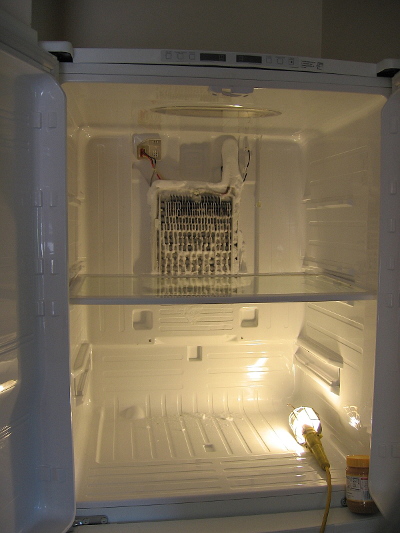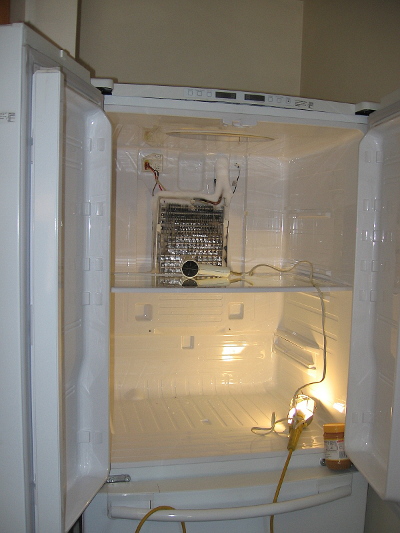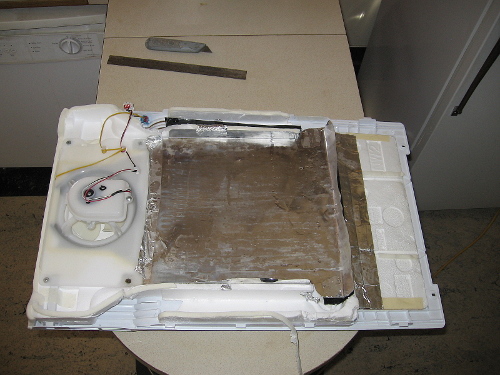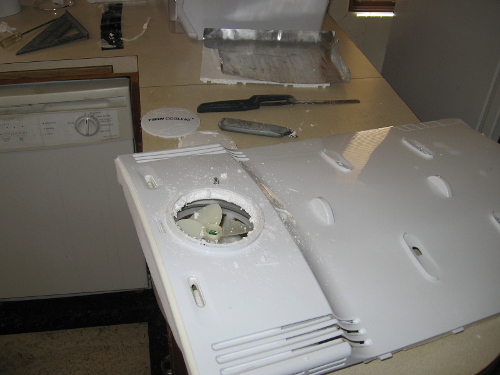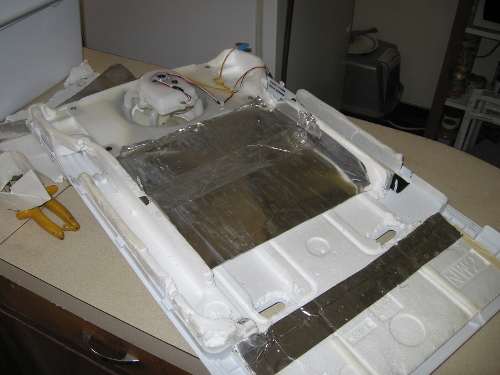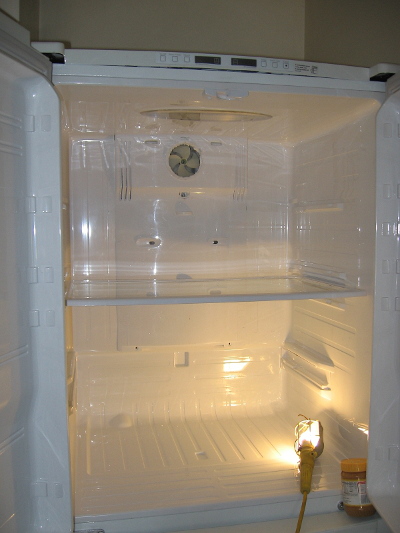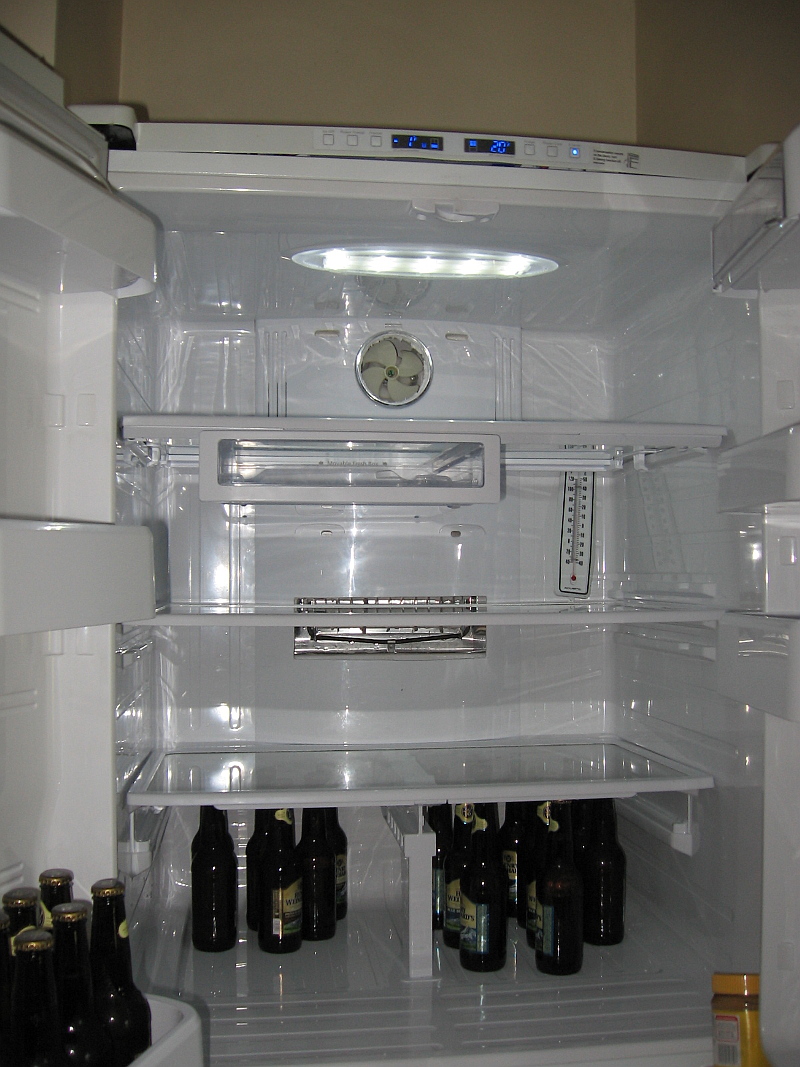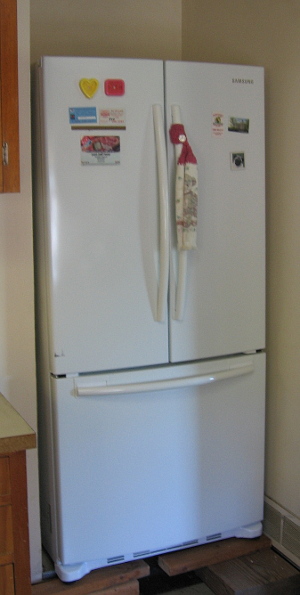
Jun 2014 -- The offending refrigerator...
This refrigerator would go about three weeks before the temp started rising above 40 degrees F, even when it spent all night with the doors closed. Removing the cooling pack cover revealed the reason why. The coil is completely iced up. This refrigerator is only three years old and my Mom is so fed up with it that she gave it to me for free. So I am going to try some drastic things to fix this beast, with the knowledge that, if I break it, I'm not out any money. Keep that in mind if you want to try these things yourself. I still have my 27-year-old Kenmore in my kitchen so I am not worried about losing food if I screw up this Samsung and break it completely (which could happen).
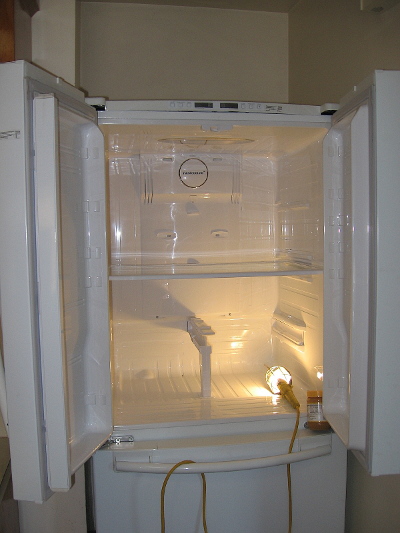
with cover on... and with the cover off and hairdryer used to start defrosting
This is the inside of the cover when I started. Note that the air flow is designed to come in the gill slits at the top (near left in this pic), travel down the sides through two narrow channels, turn 180 degrees, go upwards through the cooling pack, go through the fan and outwards, turn 180 degrees again and go down through two extremely narrow channels that are hidden in this pic between two layers of styrofoam, and then come out the four little oval holes in the front of the cover.
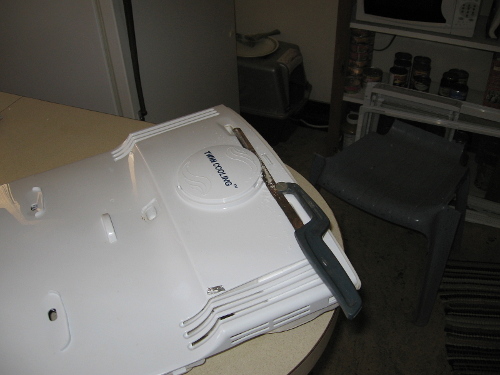
I started by trying to simplify the bizarre air flow design. I cut the front out of the fan housing so the air would be blown directly out into the refrigerator compartment, instead of going down and out those very small holes. I removed the chrome (plastic) trim ring and then cut the plastic with a hack saw blade. Then I cut the styrofoam out to reveal the fan blades. (And I put the chrome ring back on)
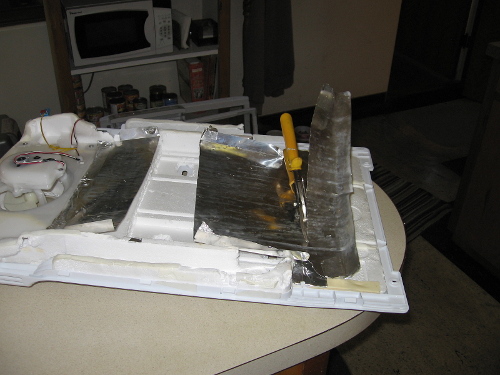
I cut the bottom 3 or 4 inches off the metal shield to allow the air to start entering by coming in those oval holes at the bottom of the cover (instead of blowing out those holes as previously). I also cut the metal shield in half at first (left pic) but changed my mind and taped it back together in the middle with duct tape. I also stuffed a couple of small pieces of styrofoam into those two almost invisible channels that used to carry the air down from the fan and then out the oval holes. Oh, and I had to cut away one layer of styrofoam to open the air holes to the bottom of the cooling pack.
With the cover back on... the airflow is now simplified. The compartment air is drawn in through the four oval holes (and the gill slits at the top) and goes upwards through the cooling pack, and then out into the compartment via the fan at the top. Much simpler airflow. Still, I don't think this will completely solve the freezing-up problem. But I put it together to wait another three weeks to try something even more drastic.
Three weeks later... I cut a large rectangular hole in the bottom center of the cover, revealing the bottom of the cooling pack. I was hoping there would be enough warm air from the fridge compartment when the compressor wasn't running to keep the cooling pack frost free. But so far it's still icing up. And one other thing. Apparently my "defrost cycle" heating element isn't working. It shows a correct resistance on an ohmmeter, so it must be that it isn't getting any electricity. My brother says I ought to spend $50 or so and buy a new controller board, but I am of the opinion that I shouldn't throw any money at all into this turkey of a refrigerator. At least with the bottom of the cooling pack revealed like this it ought to be simple to defrost with a hair dryer. And the biggest problem is still that the drain tube remains iced up, continuously, even with it all open like this. I may try some defrost cycles overnight hoping that everything in the top compartment will get above freezing long enough to melt that drain tube. But I haven't tried that idea yet.
Sep 2014 -- It's been through a couple of cycles now so I'm getting the routine of defrosting down and settled now. I keep an eye on the thermometer inside the fridge, adjusting the temp on the thermostat down whenever the inside temp starts to creep above 40 F. Eventually I can see the coil has frozen up completely and I know it's time for another defrosting. It looks like it'll go about six weeks between defrostings. I pick a good day when I'm not planning on using the fridge very much and, first thing in the morning when I get up I set the fridge on the "demonstrator" mode by pressing the power freeze and freezer buttons at the same time for three seconds. That way the inside fan and lights will work but the compressor will be off. I also remove the two lowest vegetable bins so I can mop up the melt water. I then wait about ten hours. The inside temp will get up to about 50 F but I've moved my critical items, like milk and eggs, to the other fridge and that temp won't hurt anything else. The coil finally defrosts completely, but I've never seen the drain hole become ice-free and open so I have to mop up all the melt water by hand as it runs down the inside to the bottom. Then I turn the fridge on again and -- very important -- I set the temp at 46 F which is the highest inside temp I can set it at. I found out that this thing will freeze my food when the cooling pack is defrosted like this. I lost several pounds of potatoes when they froze in the veggie bin before I figured that out. I also keep a sharp eye on the thermometer that I have rigged inside the compartment. That is the only trustworthy temperature source. I just ignore that LED display at the top of the doors except for setting the temp. I don't know where the thermostat sending unit is located. It must be inside the cooling area and must be reading colder temps that are then "translated" magically to an estimated upper compartment temp reading. But it sucks at keeping a correct temp. As the weeks go on and more frost builds on the cooling pack I adjust the "set" temp downwards from the 46 F starting temp to keep the inside between 35 and 40, where it should be. Using this method the fridge is actually usable. I'm glad I'm not having any problems with the freezer unit like some other people. The freezer works good for me, although I don't use the ice maker at all and have never hooked up the water line. No sense pressing my luck there, and I don't use ice cubes hardly at all, anyway.
Nov 2014 -- It's time for another defrosting. Looks like it went two months that time, although I really, really let the ice build up on the coils this time. The whole opening is completely blocked with ice now. It still keeps good temp, however. I think that is because the thermostat is staying on longer because the ice is blocking any air flow through the coils so the thermostat stays a bit warmer. But I decided it's time to thaw it out and today (Nov 4 - Election Day!) is the day. And I have started keeping most of my veggies in my backup refrig where I can control the temp better. This Samsung still tries to freeze my potatoes when I put them in the vegetable bins at the bottom. I don't know if I can figure out any solution to that problem. I'm keeping the potatoes in a paper sack on a shelf in the Samsung now. That seems to keep them above freezing, at least so far.
Feb 2015 -- I defrosted it again, even though it was keeping a pretty good temp in the mid-30's F. But it was completely frosted up so there wasn't any air at all moving through the cooling pack. I'm not really sure how it worked so well in that condition. But I finally decided I needed to defrost it again. I turned the demostrator mode on the night before and then I still had to use the hair dryer a little bit the next day when it wasn't melting fast enough. I was worried that the frozen items in the freezer down below would begin to thaw if it went more than 24 hours without any compressor. But it is again working fine, although I have to keep monitoring the inside temp at first because the coils, now open and passing air, will cool far better than they will later when they get clogged with ice.
May 2015 - Time for another defrosting.
Jul 2015 - Time for another defrosting.
29 Aug 2015 - Time for another defrosting. I should note that I have taken out the two veggie bins in the bottom of the fridge now. They were just making it too difficult to access anything inside with my cramped location that I have this fridge set up in. So I start my defrost chore by taking milk and eggs and putting them into my backup fridge. Then I turn the fridge to "demonstrator" mode at about 5:00 pm on the night before. I let it sit all night long, until about 6:00 am the next morning and then it only takes a couple of minutes with a hair dryer and some usage of a turkey baster to remove the water that collects in the bottom of the compartment. (I also make sure that I only put waterproof jars and so forth on the very bottom level of the fridge now, so they don't get soaked if the power should go out and it should start defrosting without my being there to catch it.) [demonstrator mode = press the 'power freeze' and 'freezer' buttons at the same time and hold for three seconds. The display will change to show '0' temps settings. Same procedure to return to normal mode.]
